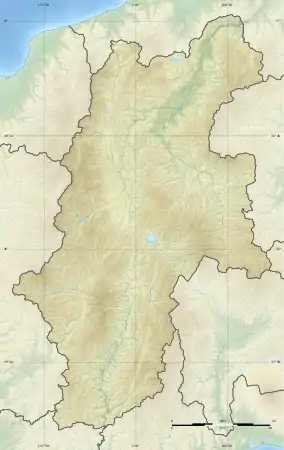Hoshigatō obsidian mine site
Hoshigatō Hoshigatō obsidian mine site (星ヶ塔黒曜石原産地遺跡, Hoshigatō kokuyōseki gensanchi iseki) is a Jōmon period archaeological site consisting 193 shallow interconnected pits over a 35,000 square meter area, from which obsidian had been mined, located in what is now part of the town of Nagawa in the Chubu region Japan. It has been protected by the central government as a National Historic Site since 2015.[1]
星ヶ塔黒曜石原産地遺跡 | |
 Hoshigatō obsidian mine site  Hoshigatō obsidian mine site (Japan) | |
| Location | Shimosuwa, Nagano, Japan |
|---|---|
| Region | Chubu region |
| Coordinates | |
| Type | settlement |
| History | |
| Periods | Jōmon period |
| Site notes | |
| Condition | ruins |
| Ownership | National Historic Site |
| Public access | none |
Overview
The site is located northwest of slope of Mount Kirigamine at an altitude of 1500 meters, in a 35,000 square meter forested area. Obsidian, or "volcanic glass" was frequently used for tools and weapons in the Japanese Paleolithic period as it could be fractured to produce sharp blades or arrowheads, and frequently occurs in volcanic formation around Japan. Excavation surveys found that obsidian was extracted from here from the early Jōmon period (about 5,700 years ago) and late Jōmon period (2000–1000 BCE). Chemical analysis also indicated that obsidian from this site was supplied to settlements distributed across an extremely wide range from Tōhoku to the Tōkai region, indicating long distance trade. The site was discovered in 1920, and was excavated from 1959-1961, and again in 1997.
There is no public access or facilities at the site.
References
- "星ヶ塔黒曜石原産地遺跡". Cultural Heritage Online (in Japanese). Agency for Cultural Affairs. Retrieved 25 December 2017.(in Japanese)
External links
- Shimosuwa town official site (in Japanese)